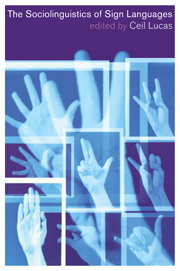Book contents
- Frontmatter
- Contents
- List of figures
- List of tables
- List of contributors
- Foreword
- Preface and acknowledgments
- List of abbreviations
- 1 Introduction
- 2 Multilingualism: The global approach to sign languages
- 3 Bilingualism and language contact
- 4 Sociolinguistic variation
- 5 Discourse analysis
- 6 Language planning and policy
- 7 Language attitudes
- Bibliography
- Index
5 - Discourse analysis
Published online by Cambridge University Press: 24 November 2009
- Frontmatter
- Contents
- List of figures
- List of tables
- List of contributors
- Foreword
- Preface and acknowledgments
- List of abbreviations
- 1 Introduction
- 2 Multilingualism: The global approach to sign languages
- 3 Bilingualism and language contact
- 4 Sociolinguistic variation
- 5 Discourse analysis
- 6 Language planning and policy
- 7 Language attitudes
- Bibliography
- Index
Summary
Everyone knows that when individuals in the presence of others respond to events, their glances, looks, and postural shifts carry all kinds of implication and meaning. When in these settings words are spoken, then tone of voice, manner of uptake, restarts, and the variously positioned pauses similarly qualify. As does manner of listening. Every adult is wonderfully accomplished in producing all of these effects, and wonderfully perceptive in catching their significance when performed by accessible others. Everywhere and constantly this gestural resource is employed, yet rarely itself is systematically examined. In retelling events – an activity which occupies much of our speaking time – we are forced to sketch in these shadings a little, rendering a few movements and tones into words to do so. In addition to this folk transcription, we can employ discourse theatrics, vivifying the replay with caricaturized reenactments. In both cases, we can rely on our audience to take the part for the whole and cooperatively catch our meaning. Thus, in talk about how individuals acted or will act, we can get by with a small repertoire of alludings and simulations. Fiction writers and stage performers extend these everyday capacities, carrying the ability to reinvoke beyond that possessed by the rest of us.
Erving Goffman (1981: 1–2)This phase of sign language behavior is of fundamental importance, and to the writers' knowledge has never been mentioned in the literature about American sign language. Many teachers and psychological counselors of the deaf who have been fairly successful in learning to make the signs and to finger spell and read the signing and spelling of deaf pupils and clients, have formed the impression that deaf persons are unresponsive, overly dependent, or lacking in self-reliance. […]
- Type
- Chapter
- Information
- The Sociolinguistics of Sign Languages , pp. 112 - 144Publisher: Cambridge University PressPrint publication year: 2001
- 12
- Cited by



